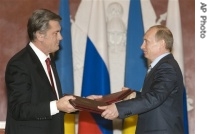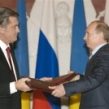
RUSSIA-UKRAINE GAS RELATIONS: MURKY AFTER PUTIN-YUSHCHENKO MEETING
Publication: Eurasia Daily Monitor Volume: 5 Issue: 30
By:

Presidents Vladimir Putin of Russia and Viktor Yushchenko of Ukraine have agreed on a reshuffling of the cards in Russia-Ukraine gas relations. During Yushchenko’s February 12-13 visit to Moscow (see EDM, February 14) the two presidents adopted on a personal basis what Yushchenko termed “tactical decisions” on gas relations for 2008 and “strategic decisions” for the years thereafter.
Regarding the latter, Yushchenko declared, “We have agreed on the strategy, but will not publicize [afishirovat] it at this time.” He disclaimed “any desire as President to have to deal with gas issues” and credited Putin with a similar aloof disinterest: “I am sure that the same is true of Vladimir Vladimirovich” (Kremlin.ru, February 12; Russia Television Channel One, February 13). Putin did not seem to take umbrage.
The decisions focus on replacing the two intermediaries, RosUkrEnergo and UkrGazEnergo, from the Russia-Ukraine gas trade. In their stead, Gazprom and the Ukrainian state company are to establish two new joint companies, each on a 50%-50% parity basis.
As Gazprom’s chairman and Russia’s president-in-waiting Dmitry Medvedev told journalists on this occasion, the intermediary’s title is immaterial as long as the system continues. Gazprom, he said, can supply gas to Ukraine at European prices of some $300 without intermediaries, if Ukraine chooses that option. But if Ukraine wants cheaper Central Asian gas, it must accept an intermediary by agreement with Gazprom. The Russian side is ready for either option, Medvedev said. He recalled that Russia had in 2005 proposed to create such an intermediary in the form of a Gazprom-Naftohaz joint company, but that the Ukrainian side favored the RosUkrEnergo solution (Itar-Tass, February 14).
The two existing intermediaries are Gazprom’s offshoots. RosUkrEnergo, 50% owned by Gazprom and 50% by Gazprom’s Ukrainian allies, buys gas from Gazprom and delivers it through Gazprom’s pipelines to the Russia-Ukraine border. UkrGazEnergo, 50% owned by RosUkrEnergo and 50% by Naftohaz — and managed by long-time Gazprom collaborators in Ukraine — buys that gas from RosUkrEnergo at the border and sells it within Ukraine. There, UkrGazEnergo supplies the lucrative industrial market and Naftohaz the debt-ridden household market. This system is in place under the January 2006 agreements signed by Yushchenko’s energy team with Gazprom.
Through this arrangement, Ukraine receives gas at prices far below those prevailing in Europe, although the price charged to Ukraine is rising each year and should reach the European level by 2011. Ukraine pays $179.5 per 1,000 cubic meters in 2008, compared to more than $300 paid by most of Gazprom’s customers in Europe. Gazprom sustains this discount to Ukraine by buying Turkmen and other Central Asian gas far below European prices, adding some volumes of “European-priced” Russian gas, and selling the mix to RosUkrEnergo for transport to Ukraine, where UkrGazEnergo distributes it to consumers. Attractive in the short term, this system of discounts is actually depriving Naftohaz of revenues, pushing it into indebtedness, and preventing it from modernizing Ukraine’s gas transit system, which Naftohaz owns and operates. By pushing Naftohaz toward bankruptcy, Gazprom aims for some form of shared control of Ukraine’s gas transit system.
In late January-early February, Gazprom threatened to reduce gas supplies to Ukraine as of February 11, unless Naftohaz begins reimbursing arrears worth $1.5 billion. By Gazprom’s accounting, $500 million of that sum stems from a suddenly increased “Russian” portion in the Central Asian-Russian mix of gas supplied to Ukraine during November-December 2007. With frost-hit Central Asia facing gas shortfalls, Gazprom compensated for the missing Central Asian volumes by adding expensive “Russian” gas for delivery to Ukraine by RosUkrEnergo. Furthermore, Moscow complains that Naftohaz bought 5 billion cubic meters of gas in January 2008 from UkrGazEnergo without a valid contract, once the price of the gas mix went up (Interfax-Ukraine, UNIAN, February 12-14).
The debt-formation mechanism has operated as follows: Naftohaz is unable to pay to UkrGazEnergo, which in turn cannot pay to RosUkrEnergo, which in its turn owes that amount to Gazprom. Thus, Gazprom turns to the Kremlin to collect the debt from Ukraine. The mechanism seems to work as Moscow intended all along.
The Ukrainian government is now looking at debt-repayment options, which — according to Fuel and Energy Minister Yuriy Prodan — include: collecting arrears from Ukrainian gas consumers, “restructuring its debts to Gazprom,” or taking yet another international loan to pay Gazprom through that chain of intermediaries.
On February 14, the Ukrainian cabinet of ministers under Yulia Tymoshenko decided to set up a commission to disband UkrGazEnergo and replace it with a Naftohaz-Gazprom parity company. Thus, Gazprom can move directly into the transmission and distribution system within Ukraine, taking over 50% of the business if this arrangement takes shape. RosUkrEnergo is to continue operating in 2008, pending its replacement in accordance with the February 12 Putin-Yushchenko agreement. That agreement is only an outline, likely to be challenged politically in Ukraine.




